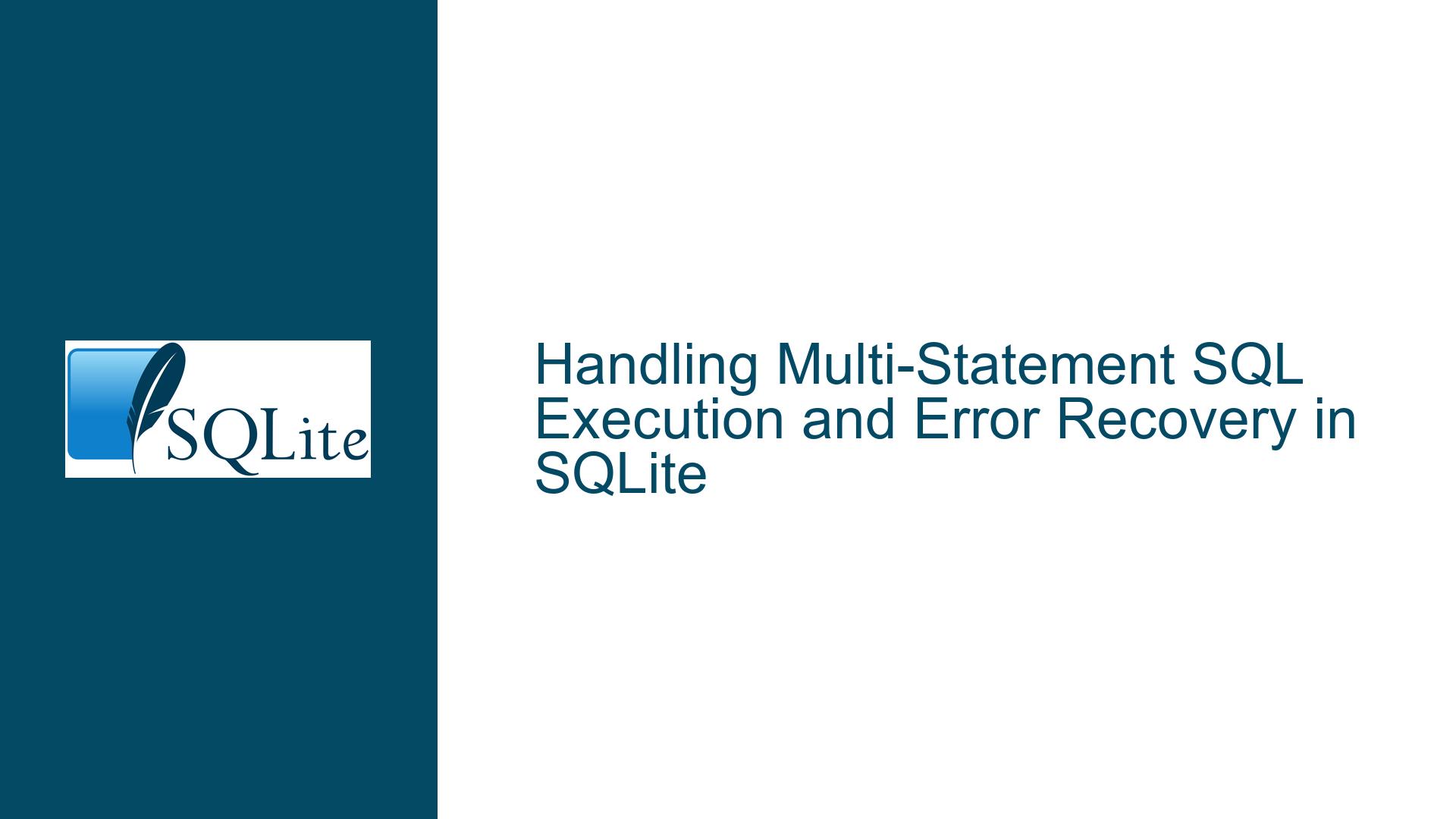Handling Multi-Statement SQL Execution and Error Recovery in SQLite
Understanding the Prepare/Step/Finalize Loop and Error Handling in SQLite
When working with SQLite, particularly in scenarios involving multiple SQL statements executed sequentially, developers often encounter challenges related to error handling and statement execution flow. The core issue revolves around the sqlite3_prepare_v2, sqlite3_step, and sqlite3_finalize loop, which is used to execute SQL statements programmatically. The problem arises when one statement in a batch fails, and the developer needs to decide whether to continue executing the remaining statements or halt the process entirely.
The sqlite3_prepare_v2 function is responsible for compiling a single SQL statement into a bytecode program that can be executed by the SQLite virtual machine. It takes an SQL string as input and outputs a prepared statement object. The pzTail parameter of this function points to the remaining portion of the SQL string after the first complete statement has been parsed. This mechanism allows for iterative processing of multiple statements within a single SQL string.
However, if an error occurs during the preparation of a statement, pzTail may point to the beginning of the failed statement, leading to potential infinite loops if not handled correctly. Additionally, the developer must decide whether to proceed with the next statement in the batch if the current one fails. This decision is not straightforward, as it depends on the logical dependencies between the statements and the desired behavior of the application.
Challenges with Multi-Statement Execution and Error Recovery
The primary challenge in handling multi-statement execution lies in determining the appropriate conditions for continuing or halting the execution loop. The pzTail pointer is central to this process, as it indicates the remaining SQL text to be processed. However, its behavior in error scenarios complicates the logic. When a statement fails, pzTail may point to the beginning of the failed statement, making it difficult to distinguish between a recoverable error and a fatal one.
Another challenge is the presence of semicolons within SQL statements, such as in CREATE TRIGGER statements. Splitting the SQL string on semicolons is not a reliable solution, as it can incorrectly split statements that contain embedded semicolons within quoted strings or comments. This necessitates a more sophisticated approach to parsing and executing multi-statement SQL strings.
The sqlite3_complete API can be used to determine whether a given SQL string constitutes a complete statement. However, this function alone does not provide a mechanism for recovering from errors or skipping failed statements. It merely indicates whether the input string is syntactically complete. Therefore, developers must implement additional logic to handle errors and manage the execution flow.
Strategies for Robust Multi-Statement Execution and Error Handling
To address these challenges, developers can adopt several strategies to ensure robust multi-statement execution and error handling in SQLite. The following steps outline a comprehensive approach:
Iterative Preparation and Execution: Use the
sqlite3_prepare_v2function in a loop to process each statement in the SQL string sequentially. After preparing a statement, check thepzTailpointer to determine the remaining SQL text. IfpzTailpoints to a non-empty string, continue the loop; otherwise, exit.Error Detection and Recovery: After each call to
sqlite3_prepare_v2, check the return code to detect errors. If an error occurs, examine thepzTailpointer to determine whether it points to the beginning of the failed statement or the remaining SQL text. If it points to the failed statement, skip to the next statement by advancing thepzTailpointer manually. This can be done by searching for the next semicolon and verifying the completeness of the subsequent statement usingsqlite3_complete.Handling Embedded Semicolons: To handle SQL statements that contain embedded semicolons, avoid splitting the SQL string on semicolons. Instead, rely on the
sqlite3_prepare_v2function to parse the statements correctly. If necessary, usesqlite3_completeto verify the completeness of each statement before attempting to prepare it.Independent Statement Execution: If the statements in the batch are logically independent, consider executing them separately using individual calls to
sqlite3_exec. This simplifies the error handling process, as each statement is executed in isolation, and failures do not affect the execution of subsequent statements.Transaction Management: Use transactions to ensure atomicity and consistency when executing multiple statements. Begin a transaction before starting the execution loop, and commit it only if all statements succeed. If any statement fails, roll back the transaction to undo any partial changes.
Logging and Diagnostics: Implement logging to record the execution status of each statement, including any errors encountered. This information can be used for debugging and diagnosing issues in the application.
By following these strategies, developers can create robust and reliable SQLite applications that handle multi-statement execution and error recovery effectively. The key is to leverage the capabilities of the SQLite API while implementing additional logic to manage the complexities of error handling and statement parsing.
In conclusion, handling multi-statement SQL execution and error recovery in SQLite requires a careful balance between leveraging the built-in capabilities of the SQLite API and implementing custom logic to address specific challenges. By understanding the behavior of the sqlite3_prepare_v2 function, the pzTail pointer, and the sqlite3_complete API, developers can design solutions that ensure reliable and efficient execution of SQL statements in their applications.






